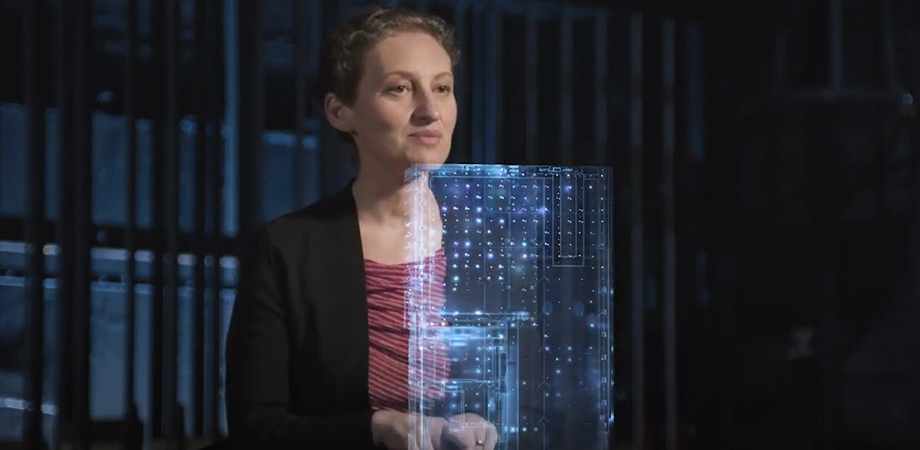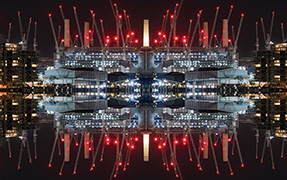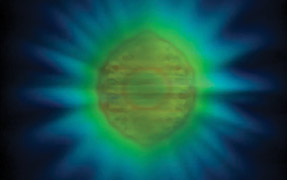#FacesofPhotonics: Astrophysicist Evgenya Shkolnik

Are we alone in the Universe?
This is the age-old question that engineers, scientists, and stargazers have been asking for centuries about whether there is life on other planets. There’s no question about it, if you ask Evgenya Shkolnik (Spoiler alert!).
An associate professor at Arizona State University (ASU), Evgenya has studied the stars, their planets, and the instruments we use to observe them for many years. “I expect that the galaxy is teeming with life,” she said in a recent interview with ASU on YouTube.
With both a Master of Science and PhD in astronomy and astrophysics, Evgenya is confident that we are at a point where we could build the telescopes needed to find evidence of life on other planets, specifically exoplanets, planets orbiting stars other than sun. One way she is helping to uncover this mystery is with the NASA-funded SPARCS (Star-Planet Activity Research CubeSat) mission. While part of her time is spent in the classroom at ASU, Evgenya is also the Principal Investigator on the SPARCS mission; the first-ever space telescope dedicated to monitoring the high-energy radiation environments of exoplanets throughout their lifetime.
“It is not standard, in an academic environment, to form teams at this scale,” she noted in the same ASU interview. SPARCS is a collaborative effort between ASU, NASA JPL, the University of Washington, the University of Arizona, the Lowell Observatory, MIT, and the Southwest Research Institute.
It’s no surprise that Evgenya is passionate about collaboration. In 2009, she helped found a GPS Group, or “Goals & Problem-solving for Scientists” Group, with fellow scientists Anat Shahar, Hannah Jang-Condell, and Alexandra Surcel. This confidential peer-mentorship group provides a supportive model through which to aid women and other minorities to succeed in STEM fields. She mentions the group in the interview, but you can also read more about it here.
Enjoy the interview with Evgenya, and don't miss her plenary talk at SPIE Astronomical Telescopes + Instrumentation 2020.

Evgenya and colleague Dr. Joe Llama visit the Subaru Telescope and the Keck Observatory at Mauna Kea in Hawaii.
1. Share the story of your favorite outreach or volunteer experience.
One of my favorite outreach experiences was one of my very first. As a graduate student many years ago, I went to give a talk to sixth graders about exoplanets and how we discover them with our telescopes. One girl raised her hand and asked, “Have you visited any of these exoplanets?” To which I responded, “No, these planets are very, very far away.” The student was clearly unimpressed, and said in a huff, “Well, where have you been?”
2. Explain your current research and what you do at your job. How does your work impact society?
A big part of my research goals is to understand the distribution of habitable environments in our galaxy, and maybe even the Universe. Did you know that there are probably more planets than there are stars in our galaxy? This is exciting, new knowledge. In order to make headway on such an endeavor, we need to understand many things about exoplanets and their host stars. My teams’ contributions lie in a few places, including characterizing the stars, primarily the stellar high-energy emission that effects the planet atmosphere formation, evolution, and the detection of possible signatures of life.
In order to do this, we need to monitor the stars at ultraviolet (UV) wavelengths, as those effect the planets’ atmospheres the most. With UV astronomy necessitating space-based telescopes, as our Earth’s atmosphere thankfully absorbs these high-energy photons, my team and I have moved into the path of building the needed instrumentation to execute these experiments. Our first such mission is SPARCS, the NASA-funded, small UV space-telescope housed in a CubeSat and due for launch in early 2022. SPARCS will stare at low-mass stars – the most dominant of planet hosts – for weeks at a time in order to study their UV variability and measure flares that directly affect the planets.

A 3D printed model of SPARCS.
3. What interesting summer job or internship did you have while in college or graduate school?
I spent every summer during my undergraduate degree doing physics or astrophysics research with a local professor. I found myself waking up in the middle of the night to check on experiments in the physics lab just because I was curious, as I was most certainly not getting paid to do that! These were invaluable experiences as they proved to me that research was what I was meant to be doing.
4. What book has impacted your professional life the most? Your personal life? Why?
Of course, it is impossible to pick just one book, but Every Other Thursday: Stories and Strategies from Successful Women Scientists by Ellen Daniell has been a pivotal part of my professional (and thus personal) life. It provided my first introduction to the structure and value of peer-mentorship at all career stages. I started a peer-mentorship group in 2009, and it’s still active today. The group is based on a model that I call the “GPS (Goals & Problem Solving) Groups”.
5. What are you most excited to see in the future development of your field?
I am most excited about the potential of detecting life on exoplanets. Yes, seriously, this is happening! This is a real, legitimate, scientific pursuit bolstered by the fact that we now know where to look and how to look. The “Are we alone?” question is hundreds of years old, and we are living in a time where we have a chance to actually answer it, if we choose to as a society. No joke!
| Enjoy this article? Get similar news in your inbox |
|



